La Roche M4A1(76)W Sherman Tank
This Surviving American M4A1(76)W Sherman Tank is in the pretty village of La Roche-en-Ardenne as a memorial.
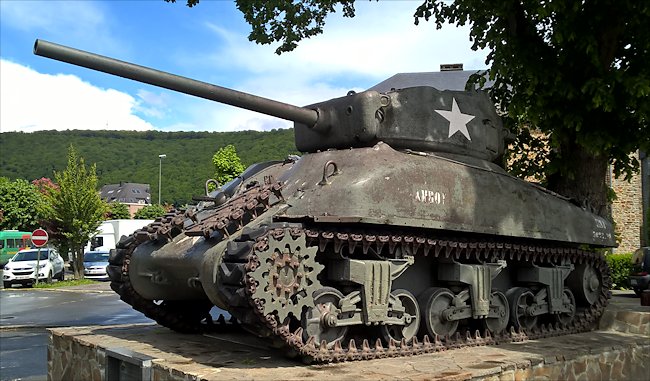
American M4A1(76)W Sherman Tank in the pretty village of La Roche-en-Ardenne, Belgium
It has been preserved as a memorial in the car park in the center of town called the Place du Gravier by the river road called Quai de lÓurthe. In 2004 it replaced a M26 Pershing tank that was on the same spot. Pershing tanks only saw action in the last months of the war in 1945. They did not play a part in the Battle of the Bulge. In 2004 it was replaced with this M4A1(76)W Sherman Tank, given the name Amboy by its crew, as it was felt to be more representative of the Allied tanks that were used to liberate the local area and the town of La Roche-en-Ardenne. The M26 Pershing went to Le Camp Roi Albert in Marche.
Pay close attention to the front of the tank under the turret. You will see that there is a hole in the armour and that it is cracked. This is war damage. It was hit by a German artillery howitzer high explosive shell and twice by a German anti-tank gun firing armour piercing AP rounds. One hit the tank turret's gun mantlet and went straight through and the another penetrated the front of the tank killing the crew.
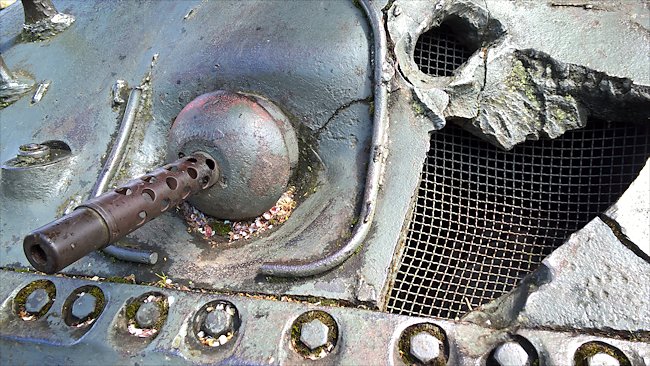
American M4A1(76)W Sherman Tank in the pretty village of La Roche-en-Ardenne, Belgium
The Sherman Tank development
In accordance with US Army doctrine, that the tank would function as an infantry support weapon, the Sherman tank was specifically designed to favor speed, mobility and mechanical reliability over firepower and protection. It was felt that tanks had no business jousting with other tanks, and that this task should be left to Tank Destroyers (TDs). The Sherman Tank Sherman Tanks were regarded as infantry support weapons, in the case of those belonging to independent tank battalions, or as tools for rapid cavalry exploitation of breakthroughs, in the case of armored divisions.
The US Army believed that any breakthroughs would be accomplished by the infantry divisions with local support from the independent tank battalions. Once a gap was made in an enemy line, the plan was then for armored divisions to pour through and wreak havoc in the enemy rear, destroying reinforcements, disrupting the command structure and forcing the enemy infantry to flee or be destroyed.
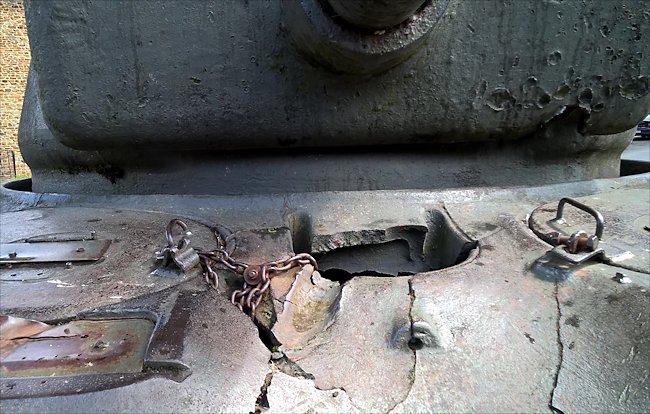
American M4A1(76)W Sherman Tank in the pretty village of La Roche-en-Ardenne, Belgium
This American approach was in distinct contrast to German doctrine, which viewed the Panzer divisions as a vital mass of mobile firepower, central to the securing of the breakout against both armored and unarmored opposition, as well as to the rapid exploitation of success. This view was widely supported by the Army general staff, including General George Marshall.
The basic fallacy of this American doctrine was the inability of the tank destroyers to deal completely with enemy tanks. Tank destroyers were essentially under-armored tanks with slightly bigger guns. They were open-topped and were very vulnerable to overhead airbursts, mortar fire and even dedicated infantry attack. They were adequate weapons for ambush or fire support.
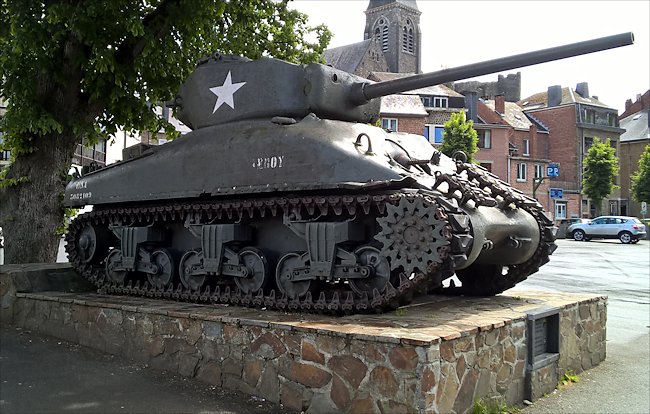
American M4A1(76)W Sherman Tank in the pretty village of La Roche-en-Ardenne, Belgium
The Sherman M4A4 tank held its own or was better than Germany's Panzer III and early model Panzer IV tanks, encountered in North Africa and Sicily in 1942 and 1943. The Sherman's armor had been designed to resist the 37-mm PAK 36 anti-tank gun used by German infantry at the start of the war.
By the time of the Normandy campaign in 1944, the Sherman was badly outclassed by German medium and heavy tanks of that day, the Panther and the Tiger, as well as the improved models of the Panzer IV tank.
The armor of a Sherman could be penetrated at most ordinary combat ranges by any of the tanks and self-propelled guns commonly in German service in 1944. More protection through heavier armor plating was neither implemented nor even seriously considered because the chassis of the Sherman, then in mass production, could not accept the additional weight without sacrificing mechanical reliability.
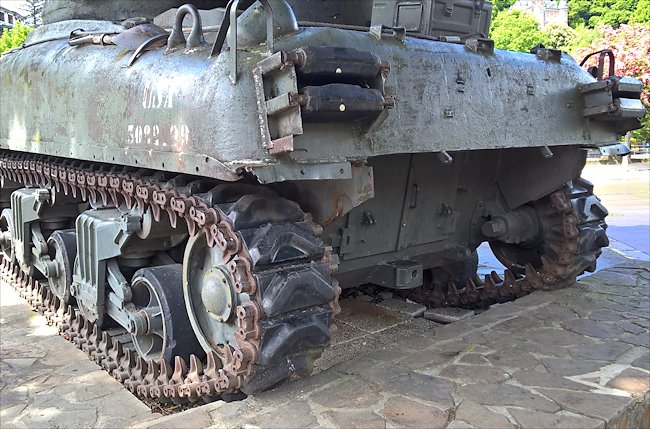
American M4A1(76)W Sherman Tank in the pretty village of La Roche-en-Ardenne, Belgium
The meager resources for tank research and development in the US Army forced hard choices that often degraded the ultimate combat capabilities of the tank. The Sherman's low-velocity 75-millimeter gun was chosen because the Army's artillery branch wanted a cheap, reliable weapon for fire support.
In another cost-cutting move, many Shermans were equipped with a radial engine originally designed for aircraft. On the battlefield, this engine produced a loud backfire when starting, instantly drawing enemy fire.
Other design deficiencies of the Sherman were the storage compartments for ammunition. The ammunition bins within the crew compartment were located along the outer shell of the tank. When enemy shells penetrated the tank, more often than not, it also exploded this stored ammunition. The resulting fire and explosion had a disastrous effects on the crew and, in many cases, the tank was completely destroyed.
With the Sherman in full mass production by American industry and the Army's doctrinal thinking stuck in a pre-war mode, innovations in tank technology were stymied. Even though a prototype for a heavier American Tank had been developed, in 1943 the AGF nevertheless opposed the production of the M26 Pershing.
Part of the resistance within the US Army to a heavy tank like the M26 to supplement the Sherman was a legitimate concern over logistics. American tanks had to be shipped thousands of miles to distant battlefields in Europe and the Pacific, and every extra ton of tank was a ton less of other vital supplies. The M26 Pershing weighed nearly fifty percent more than the Sherman and would require elaborate new training, new spare parts and new ammunition. Experiments showed that two Sherman tanks could fit into the space required by one Pershing on a Landing craft.
The Sherman tank did have some advantages over the German tanks, the greatest being its sheer numbers. At the height of production, one Sherman rolled off the production line every thirty minutes. The fact that the 75-mm gun could not penetrate the front of a German tank meant that Allied tank crews had to employ a different tactic than a one on one frontal attack. The Sherman crews would often defeat superior enemy tanks by outmaneuvering and ganging up on the Nazi tank.
With a number of Shermans engaging a German tank, some of the Shermans could surround the enemy and get a shot at the thinner and weaker armor on the side or rear of the German tank, thereby disabling it. Although this tactic worked, it was costly. It has been estimated that four Shermans were lost for every Panther or Tiger destroyed.
Another tactic was to have a Sherman remain hidden. Once the German tank got close enough, a shell from the hidden Sherman, could penetrate into the side of the advancing German tank and knockout the enemy.
One of the Sherman's main strengths was the speed with which the turret could be traversed. The turret was powered by a hydraulic and electric system that enabled it to make a full revolution in only 10-12 seconds, compared with 25 or more seconds required by German tanks which were frequently turned by a hand crank. The Sherman's quick-turning turret often allowed it to get off a crucial first one or two shots in a tank duel.
Other strong points over its German counterparts was the Sherman's higher rate of fire, and its higher degree of mobility. It was quicker and more maneuverable. The Sherman tank also exhibited high mechanical reliability — unlike the German Tiger and Panther tanks, which experienced frequent breakdowns. A minor breakdown in battle could be disastrous, exposing it to enemy fire resulting in the complete loss of a tank. The simplicity of the Sherman tank design lent itself to not only ease of production in great quantities but also relatively easy maintenance and repair in the field. In this respect the Sherman had a decided advantage over the German tanks.
The tank commander sat behind the gunner and slightly above him when the turret hatch was closed. The commander's seat, like the driver and assistant driver, could be raised when the hatch was open. In this position, the commander's head and upper torso was exposed when the tank was not in combat. The commander also had direct control over the turret's traverse and could set the main gun in the direction of the target himself, but leaving the more precise aiming to the gunner. The commander also operated the radio, through which he communicated with other tanks and headquarters.
Second in seniority was the gunner, usually a corporal. The gunner aimed and fired the 75-mm gun onto the targets indicated by the commander. He sighted the target through a periscope and traversed the turret and elevated the gun in order to effect the fire. He also fired the co-axial machine gun. The gunner's position was on the right side of the turret, immediately in front of the commander and behind the assistant driver. The tasks of the gunner required considerable training and the fate of the crew could often depend on the gunner's skill.
The driver was next in seniority and was located on the left front side of the tank. Driving the tank was accomplished by a clutch-and-brake steering system. In addition to possessing the skills necessary to drive the tank, the driver had to have a reasonably good appreciation of tactics and terrain.
During battle, the commander many times relied upon the driver to align the tank in the best position for the gunner to achieve the most effective firing as well as positioning the tank to avoid enemy fire. The lowest in seniority were the loader and the assistant driver/bow gunner. The loader's primary function was to keep the main gun and the co-axial machine gun in working order and supplied with ammunition. Of all crew members, the loader had the most room because he was required to reach all around the central portions of the tank to the areas where the ammunition was stored. The assistant driver, located in the right front of the hull of the tank. He was primarily responsible for operating the .30 caliber bow machine gun. He also assisted the loader by feeding him ammunition from the forward bins.
The driver and the assistant driver entered and exited through hatches directly over their positions in the forward hull compartment of the tank. Both were furnished with seats which could be raised, so that their heads emerged from the hatches. This was how they operated the tank when not in combat situations. When the hatches were closed during combat, both used a periscope on the hatch covers in order to drive the tank. When the tank was in operation, the noise was deafening. One tanker described it as like being inside a cement mixer. Conversation was impossible and the crew communicated vital information to each other by a rudimentary intercom system. One Sherman Gunner explained. 'You couldn't talk to anybody in the tank it too noisy. We had a little strap around our throat with a button on the end and a thing in our ear and when we talked you could hear like through the speaker thing.'
WW2 tank books

